By age six months, our pediatrician wanted us to begin spoon feeds with the babies. It doesn’t take a mathematician to figure out that using jarred food is not the most frugal way to feed four babies so we set out to make our own. When we first began making our own baby food we started solely with fresh produce bought in bulk: pears, bananas, avocados, and butternut squash. As the babies soared at noshing on these purees, we knew it was time to expand their palates. While we found making everything fun, it was also very time-consuming. George and I stepped back and considered our goals in feeding the babies solid foods. We determined it was to provide them with nutritional food and expose them to a variety of flavors and textures. Also when caring for four babies we are always budgeting two things: time and money. No doubt, homemade baby food offers a substantial savings over jarred baby food and is also more wholesome. However, making everything from scratch is not always the best way to budget our two precious commodities. Thus, I started getting creative in making “semi-homemade” baby food. When I go shopping to make baby food I divide what I will make into these categories: fresh produce, frozen produce, dairy, and canned foods/pantry items. When there is no price difference, I always choose organic. If there is a higher price, I only choose organic if it is an item with thin skin that is eaten (e.g. berries), but don’t put too much stalk into trying to buy all organic. The last few times I went shopping, I tracked some of the price per ounce to help compare to jarred baby foods. On average a jar of baby food costs $.16/oz. I’ve listed the average cost of items we buy regularly (for items where I kept data at least) for comparison.
Fresh Produce
Without a doubt fresh produce generally offers the most nutritional value. When selecting items to puree I consider the price: what is in season and on sale? I also consider ease of preparation. I choose items that involve the fewest steps possible. For example, bananas are both the cheapest and simplest to prepare: peel and puree. That’s it. Whereas making pears requires: washing, peeling, steaming, then pureeing. That is a four step process! So if you are going for fresh produce think cheap & easy!
My top picks for fresh produce are:
bananas $.04/oz
avocados $.08/oz
sweet potatoes (I bake them then pull the skins off and mash)
squash
baby carrots $.05/ oz
berries (any variety in season)
Frozen Produce
I found that frozen produce is an excellent way to supplement fresh items. Many times frozen produce contains the same (or greater) nutritional value as fresh because it is frozen at the peak of ripeness, and they offer items that may not be in season. I buy some of our frozen produce items in bulk from Costco, but I also buy small steam in bag varieties on sale at the grocery store. The smaller bags are perfect for the first time we sample something new. I toss them in the microwave for five minutes to steam then puree in the Baby Bullet. If the babies have an extreme aversion to them or an allergy then I don’t have to contend with an abundance of something. Also, I’ve found some steam in bag veggies that aren’t available in bulk. There are even some items such as fruits that do not require steaming at all. I let them thaw in the blender or Baby Bullet then puree them.
My top picks for frozen foods are:
berries (any variety) $.12-$.15/oz
peaches $.09/oz
broccoli $.06/oz
green beans $.06/oz
mixed vegetables
corn $.06/oz
peas $.06/oz
spinach $.06/oz
Dairy
Dairy items offer great sources of calcium and protein while taking a tart fruit or bitter vegetable down a notch. As far as yogurt goes, I price compare at the grocery store considering what is the least expensive per ounce. I stray away from “Light” versions due to the aspartame contained in them.
My go-to items from the dairy section are:
yogurt (I use both flavored and plain) $.07/oz.
ricotta cheese $.08/oz
cottage cheese $.07/oz
Canned Goods/ Pantry Items
Believe it or not, I find great baby food items in the canned food section. I check for the items with the fewest ingredients and additives and avoid anything that says “syrup”. Also, look for cans that are BPA free. Canned beans offer excellent sources of protein and require no cooking while canned pure pumpkin is chock full of fiber and vitamins. The best part about using canned goods is they do not require cooking, refrigeration, or freezing and travel well. When we take the babies out, we often bring cans of pumpkin and cups of applesauce.
On my list of canned goods/ pantry items are:
beans (all varieties) $.06/oz
pure pumpkin (NOT pumpkin pie filling) $.06/oz
corn $.05/oz
asparagus $.10/oz
applesauce $.05/oz
chicken, beef or vegetable stock (I sometimes add these to veggie purees as a source of protein)
I have a few favorite “recipes” for the babies and have also begun to puree the side dishes from our meals to make preparation much easier. As of right now, each “recipe” is one meal for all four babies, so it makes about four servings.
1. Creamy Corn
Steam 2 c. corn (or use one can corn rinsed and drained) then puree with 1/2 cup cottage cheese
2. Pumpkin Soufflé
mix 1 can pure pumpkin (NOT pie filling) with 1 c. applesauce and add a dash of brown sugar and cinnamon
I also do the same “recipe” with 1/2 c.-1 c. pureed carrots
3. Fiesta Beans and Corn
rinse and drain 1 can of beans (any kind), puree with 1 c. steamed corn (or one can corn rinsed and drained) and 1/2 c. plain yogurt
4. Pre–lasagne
steam a 12 oz bag of spinach and puree with a handful of grape tomatoes and 1/2 c. ricotta cheese
the babies also enjoy just spinach and ricotta cheese without the tomatoes
5. Refried Beans
drain and rinse 1 can of beans (any variety) then puree and blend in 1/4 c. plain yogurt
6. Fruity Oatmeal Smoothie (It occurred to me that minus the oatmeal I can also have this for breakfast if I double the recipe)
thaw 1 c. frozen berries then puree with 1/2 a banana, blend in 1 c. yogurt and 1 c. baby oatmeal
7. Green Bean Casserole
steam 1 -2 c. frozen green beans and puree with 1-2 baked potatoes (skin removed), use chicken or beef broth to get a smooth consistency
8. Sweet Peas
steam 1 c. frozen peas then puree with 1 c. applesauce
Disclaimer: Follow the advice of your pediatrician regarding which foods to serve to your baby and when. Our pediatrician happens to be rather liberal and only has two rules for feeding babies after age 6 months 1. NO honey before age one 2. serve one ingredient at a time and wait 2-3 days before introducing a new one, monitoring for any signs of allergy. I used the following books as a guideline when preparing food for our babies:
What are some of your favorite baby food combinations or recipes? I’d love to hear what other culinary creations babies are being served.
hugs!
Amber

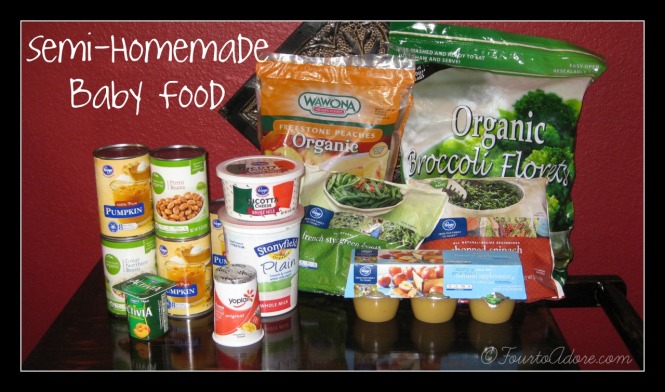

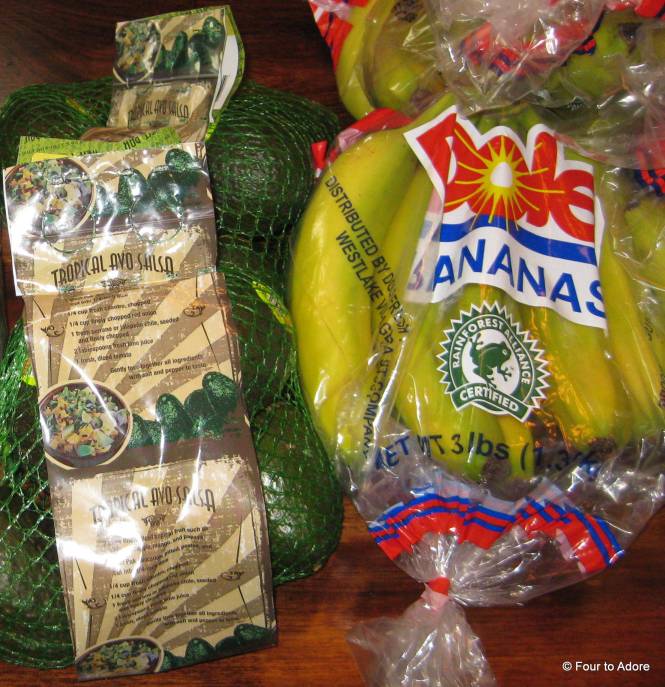
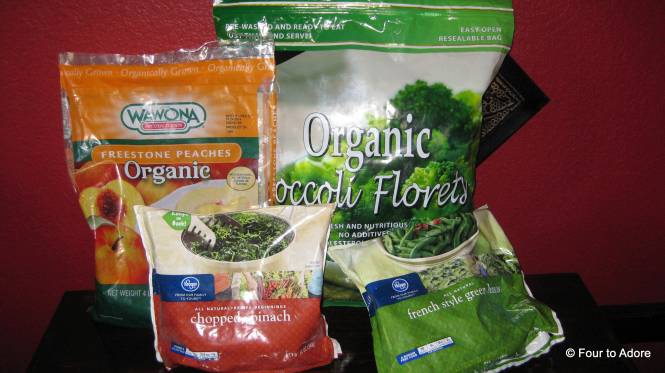
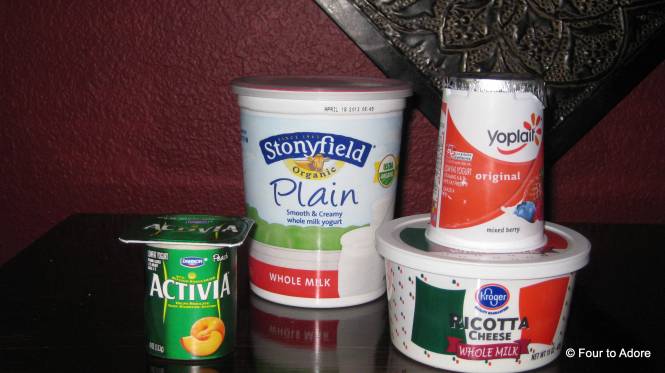
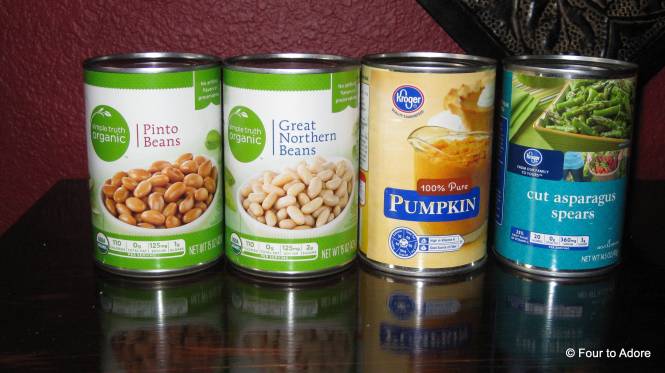
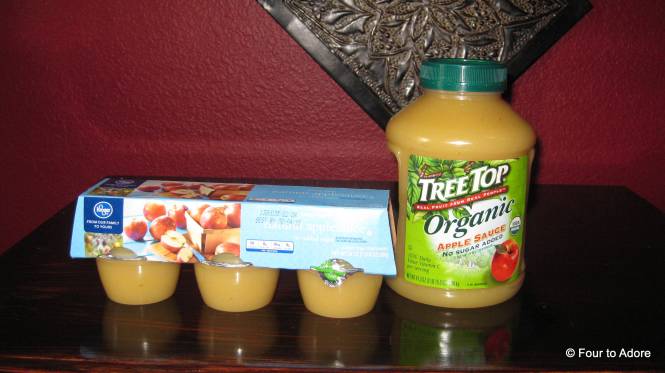




Amber, great tips!!! I just printed out this blog and will buy food for & make these recipes ASAP! I realize I have been in a major baby food routine of the same old same old… so I am very glad to expand the palates! Thanks so much!!!
LikeLike
Yay! I hoped it would be helpful. I just started blending things together and found they enjoy medleys so much more. I sometimes add a dash of salt, pepper or garlic if its super bland. I taste test everything since the kiwi incident 😉
LikeLike
Wow, what a list! This is a great resource for parents who want to make their own purees. Good work! I just wanted to point out two things you may or may not be aware of (after all, you are pretty busy!) The flavored yogurts have a ton of sugar in them, you could totally stick with plain and add your own frozen or fresh fruit. Also, most canned veggies have added salt and most canned goods are lined with BPA 😦 So hard to stay away from that stuff! Just a couple things I thought of while reading. I’m a new reader and enjoying your blog. Plus, your babes are total cuties!
LikeLike
You are correct, there are a few less than desirable additives in food that aren’t fresh or frozen. I try to steer clear of the worst offenders, added syrups and sodium, but I can’t police every ingredient on the spectrum. I am ok with that. The majority of what the babies eat us still fresh or frozen so additives are minimal. Thanks for reading!
LikeLike
Thank you so much for this information! I have been trying to find some guidance with homemade baby food! I’m not a big “naturalist” but I surely appreciate saving the money!
LikeLike
So happy it is helpful to you! I try to be “natural”, but I’m not the best at that. Money saving I do love!
LikeLike
[…] Semi-Homemade Baby Food 6 comments April 2013 […]
LikeLike
[…] a foodie would appreciate. When the quads were six months old, we excitedly began serving up homemade baby food and took great pride in expanding their […]
LikeLike
[…] the babies began eating solid foods, I made baby food from fresh, frozen, canned, and dairy products. It was surprisingly simple to make, and the babies really enjoyed it. Consuming a lot of […]
LikeLike
[…] tones of different recipes to try. Check out Four to Adore for more fun homemade baby food […]
LikeLike